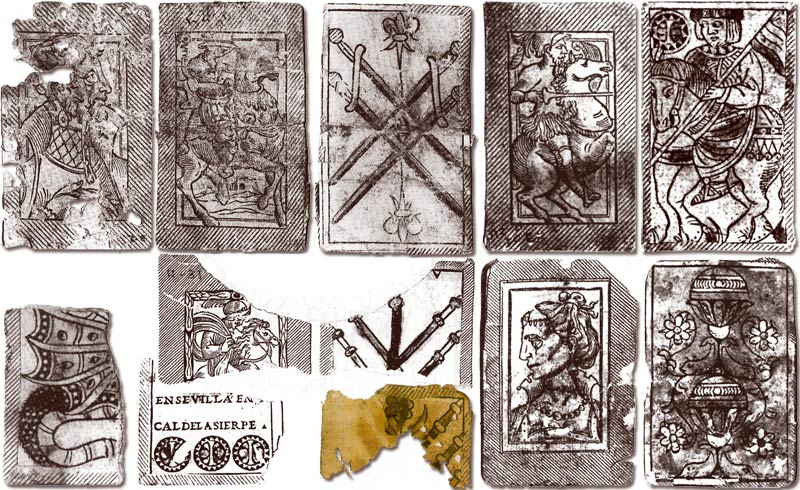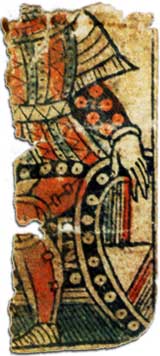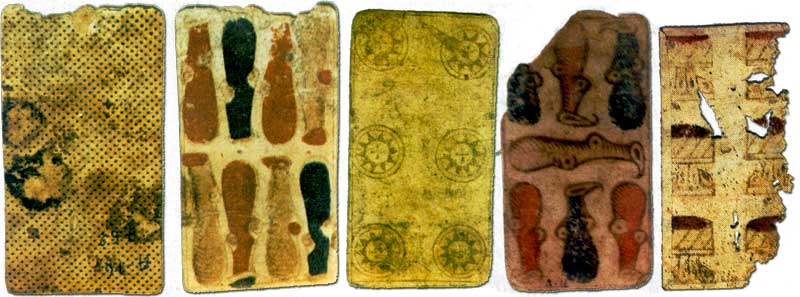16th century cards discovered in Peru
Fragments of playing cards and 2 dice were unearthed in a 16th century rubbish tip adjacent to a Spanish house in the lower Rimac Valley in Peru, providing evidence of games played by early Spanish settlers.
16th Century Spanish Playing Cards discovered in Archaeological Dig in Peru
33 fragments of playing cards and 2 dice were unearthed in a 16th century rubbish tip adjacent to a Spanish house in the lower Rimac Valley in Peru, providing evidence of games played by early Spanish settlers. In amongst the rubbish associated with the cards there was also a paper document dated 1516.
The cards are from more than one pack, and fall into two groups. The first group comprises cards of the archaic Spanish-suited "Dragon" type of pack, whilst the remaining cards are of a different early Spanish-suited pattern. Together these cards provide stunning evidence of early Spanish playing card production exported to Central and South American countries very soon after the 'discovery' of the New World.

 Above & Right: fragments of playing cards of the "Dragon" type made in Seville (Spain) discovered in archaeological excavations in the Lower Rimac Valley, Peru, during 1964-66. The backs of the cards, showing warriors and portraits of individuals in 16th century European fashion, were designed to wrap around the edges of the cards thereby providing a border around the fronts. This can be seen on the four of swords, the cavalier of coins, the two of cups and the fragment of the "Dragon" Ace at the lower left. The inscription "En Sevilla en Cal de la Sierpe" appears on one card. The two of cups is supported on two tiny dolphins. [Source of images: Cárdenas Martin, 1999]
Above & Right: fragments of playing cards of the "Dragon" type made in Seville (Spain) discovered in archaeological excavations in the Lower Rimac Valley, Peru, during 1964-66. The backs of the cards, showing warriors and portraits of individuals in 16th century European fashion, were designed to wrap around the edges of the cards thereby providing a border around the fronts. This can be seen on the four of swords, the cavalier of coins, the two of cups and the fragment of the "Dragon" Ace at the lower left. The inscription "En Sevilla en Cal de la Sierpe" appears on one card. The two of cups is supported on two tiny dolphins. [Source of images: Cárdenas Martin, 1999]
The fragment of the King of Swords (right, enlarged) shows that the quality of the woodcutting is very fine and detailed. The colours used are: black, red, blue and ochre. These cards are example of a distinctive pattern known as "Dragon Cards" owing to the winged dragons or sea monsters on the four aces. The kings are seated on thrones. Cards such as these have been found in various parts of the world, having been exported by early Hispanic colonisers. Early Spanish/Portuguese type playing cards found in Netherlands →
This pattern has long been extinct. A fine example is preserved in the Archivo de Indias in Seville manufactured by Francisco Flores, along with a sheet of similar allegorical back designs with Mexican imagery, and the contract for one Alonso Martínez de Orteguilla to administer the manufacture and sale of playing cards in New Mexico in 1583 (see mock-up of four cards shown below). The deduction which might be made is that cards like these were being manufactured in Spain and exported into the newly colonised 'New Spain' since some time in the 16th century, possibly as early as 1516.


Above: 5 cards from the second set discovered in the excavations, which belong to standard Spanish-suited packs of the day. Only the right-hand card appears to have the 'turned over' edges as in the first set, and they are of a simpler design on the front and back, which would amount to efficiency gains in production. Unfortunately no court cards are available to identify the pattern, but they are consistent with other known 16th century examples. As it happens, Seville was an attractive destination for gamblers during the sixteenth century learn more →
References
Cárdenas Martin, Mercedes: Dados y Naipes del Siglo XVI en una Huaca del Valle del Rimac, Peru, Boletín de Lima Vol.XXI, No.116 (1999) pp.42-60.

By Simon Wintle
Member since February 01, 1996
I am the founder of The World of Playing Cards (est. 1996), a website dedicated to the history, artistry and cultural significance of playing cards and tarot. Over the years I have researched various areas of the subject, acquired and traded collections and contributed as a committee member of the IPCS and graphics editor of The Playing-Card journal. Having lived in Chile, England, Wales, and now Spain, these experiences have shaped my work and passion for playing cards. Amongst my achievements is producing a limited-edition replica of a 17th-century English pack using woodblocks and stencils—a labour of love. Today, the World of Playing Cards is a global collaborative project, with my son Adam serving as the technical driving force behind its development. His innovative efforts have helped shape the site into the thriving hub it is today. You are warmly invited to become a contributor and share your enthusiasm.
Related Articles

French Revolutionary cards by Pinaut
Seven cards from a French Revolutionary pack by Pinaut featuring characters from classical antiquity...

Tarot de las Coscojas
Historical playing card design, tarot symbolism and an almost psychedelic medieval surrealism.

Tarot de Valverde de la Vera
A series of 24 surrealist engravings by Mexican artist Claudio Favier in which archetypal Tarot alle...

Baraja de Juan Martín Zamorano
Deck inspired by El Pendón de los Zamorano, a military pennant dating from 1501, published by Priego...

Heráldica Castanyer No. 16
Strange variant of international pattern cards for poker or bridge.

Fantasy Spanish-suited deck
Fantasy Spanish-suited deck by Bertschinger y Codina, Barcelona.

Bertschinger y Codina - Cartes Françaises
French ‘Paris’ pattern made by Bertschinger y Codina, Barcelona, c.1850.

Braulio Fournier
Baraja Nº 1 produced by Braulio Fournier, Burgos, c.1868.

Pirritx eta Porrotx
Happy Families card game from the Spanish Basque Country.

Naipe Vizcaino
‘Naipe Vizcaino’ designed by Javier Urkiri and published by Industrias Gráficas Castuera and the Caj...

Baraja Turística del País Vasco
Basque poker deck of 55 cards published by Fournier with scenic views of the Basque Country.

Baraja Vasca
Spanish Basque Country deck with original drawings by María Isabel Ibañez de Sendadiano.

Baraja Cultura Española
ASESCOIN pack for 2022 designed by M.A. Corella featuring famous Spaniards and notable buildings.

Laurenzo Propagine
Spanish-suited cards made in Italy by Laurenzo Propagine.

Jeu de 7 familles Les Dynasties d’Artisans Basques
Long-standing Basque businesses represented in a traditional card game with illustrations by Odile A...

Archaic Franco-Spanish pattern
Archaic Franco-Spanish pattern by Guillaume & Jean Grossard (Bordeaux).
Most Popular
Our top articles from the past 28 days

